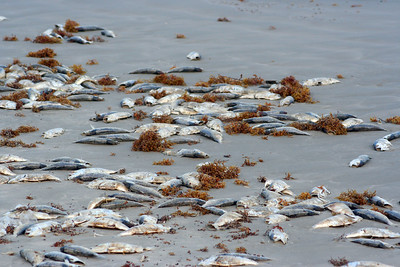Red tide is an example of a harmful algal bloom, or HAB. The majority of HAB species are phytoplankton (floating algae, mostly single-celled). However, they also include some tiny microalgae that live attached to plants or other substrates as well as some species of larger algae.
The specific causes of HABs are complex and are not always well understood. One problem in understanding bloom causes is how widely they vary between species and locations. But in general, algal species multiply when environmental conditions — nutrient and light availability, temperature and salinity — are optimal for cell growth. Not all algal blooms are harmful. Only when they are able to cause harm to humans or ecosystems do we consider them to be a HAB.
Red tides occur around the world and are caused by many different algal species. Although we call them red tides, they are not always red. Our red tide is caused by one species of dinoflagellate known as Karenia brevis. K. brevis naturally occurs in the Gulf of Mexico. Bloom initiation occurs offshore and is associated with inorganic nutrients brought up from the deep ocean. Cells are transported towards shore by ocean currents. Winds, currents and upwelling conditions further transport blooms. Although K. brevis initiation is exclusive to the Gulf of Mexico, every so often cells find their way around the Florida Keys to the east coast by way of the loop and Florida currents. The last time this happened was in 2018.
K. brevis requires nutrients to bloom and to sustain bloom conditions. K. brevis can use at least 13 different sources of nutrients, including multiple forms of both nitrogen and phosphorus, and these nutrient sources vary among the offshore, nearshore, and estuarine environment. Ammonia is its preferred form; however, K. brevis will use other forms when ammonia is limited. There is no direct link between human-derived nutrients (fertilizers, sewage, etc.) and the initiation of red tide blooms. However, once blooms are transported inshore, these nutrient sources may be used to fuel and sustain a bloom.
Red tide’s toxic effects
K. brevis produces a toxin called brevetoxin. Brevetoxins may be released into the air when wind and wave actions cause the algal cells to break open. During a red tide event, brevetoxins may be detected up to 1-2 miles away from the bloom, depending on wind conditions. Healthy individuals may experience some irritation on exposure, but these symptoms typically subside once they leave the impacted area. Aerosolized brevetoxins can however result in more severe and prolonged breathing problems for individuals with respiratory conditions, such as asthma. As such, at risk individuals should avoid red tide areas.
Brevetoxins can accumulate in filter feeders, such as clams and oysters, and may lead to Neurotoxic Shellfish Poisoning in people who consume contaminated shellfish. As a result, Florida’s waters are extensively monitored and closed to shellfish harvesting when cell concentrations exceed safe levels. Shellfish purchased through a reputable dealer or at a restaurant are safe to eat during red tide events, as they will have been harvested from waters outside of the bloom area.

K. brevis can cause fish kills in a couple of ways. Brevetoxins can affect the central nervous system of fish, causing them to die. The decay of dead fish and red tide cells can deplete the water of oxygen, leading to additional mortality of fish and other sea creatures. Fish that are caught during a red tide bloom are safe to eat as long, as they are filleted and were acting normally when caught. This is because the brevetoxins do not accumulate in the muscle tissue of fish (the part we eat). Struggling fish or dead fish found floating, no matter how fresh, should not be consumed because there is no way to know for certain what caused or is causing the mortality.
Red tide trends
About every 10 years or so, we experience a super bloom. Scientists are not exactly sure what causes this, but they are exploring different hypotheses. The most recent super bloom event lasted from September 2017 until January 2019. Super blooms also occurred in 2005-06 and 1994-96. In fact, super blooms have been documented since scientists began tracking red tide blooms. Although we certainly remember the super blooms, it’s interesting to note that red tide blooms have occurred 57 of the last 66 years in Florida. That seems to indicate that red tide has been a common occurrence here for a long time.
Helpful information about red tide
There’s really no way to predict how bad a bloom will get or how long it will last, but there are a number of resources available to readers to help them make informed decisions when planning outdoor activities during red tides. The Florida Fish and Wildlife Conservation Commission maintains a daily sample map that shows results from the last eight days of red tide sampling. In addition, forecasting tools have been developed that predict where a bloom might move over the next four days. During a bloom, red tide tends to be patchy. As a result, impacts can vary widely from one beach to another and over the course of a day. New tools are being developed to forecast respiratory irritation due to red tide blooms at every beach every day. These decision tools will allow beach goers to determine where and when conditions are forecast to be most favorable for visiting beaches during a red tide event.
 1
1
